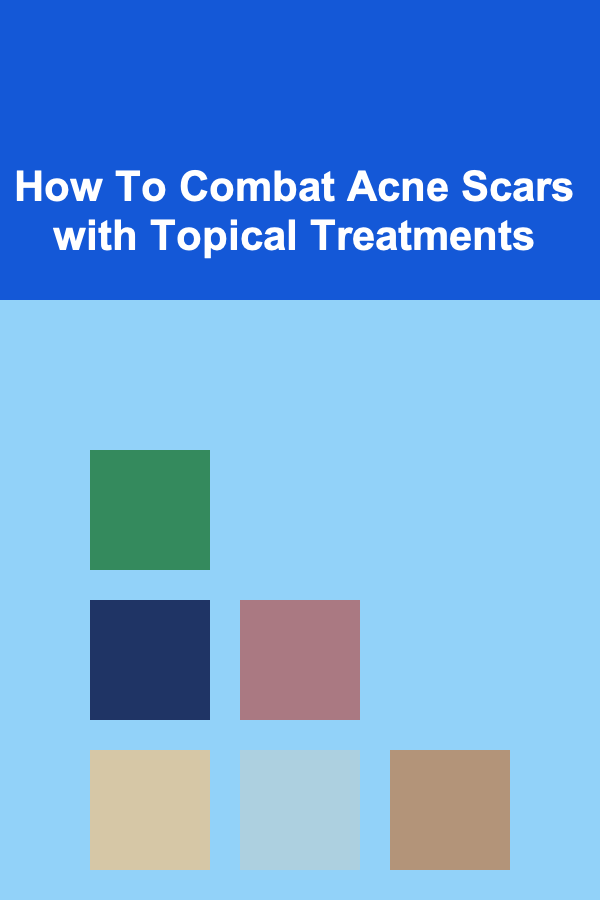
How To Combat Acne Scars with Topical Treatments
ebook include PDF & Audio bundle (Micro Guide)
$12.99$5.99
Limited Time Offer! Order within the next:

Acne scars are a common concern for individuals who have experienced acne, whether it is mild or severe. These scars can have a significant impact on one's self-esteem and confidence, and for many, the battle with acne scars can feel endless. Fortunately, several topical treatments are available that can help diminish the appearance of acne scars and improve skin texture over time. In this article, we will explore the different types of acne scars, the best topical treatments for acne scars, and how to incorporate these treatments into your skincare routine.
Understanding Acne Scars
Before diving into the treatments, it's important to first understand the different types of acne scars. Acne scars can vary in appearance depending on the severity of the acne, the individual's skin type, and how the skin heals after the breakout. There are generally three primary types of acne scars:
1. Atrophic Scars (Depressed Scars)
Atrophic scars are the most common type of acne scars and are characterized by sunken or indented areas on the skin. These scars occur when the body fails to produce enough collagen during the healing process, leading to a loss of tissue. There are three subtypes of atrophic scars:
- Ice pick scars: Deep, narrow scars that resemble puncture holes.
- Boxcar scars: Broad, angular depressions with sharp edges.
- Rolling scars: Shallow, wavy scars that create a rolling texture on the skin's surface.
2. Hypertrophic Scars (Raised Scars)
Hypertrophic scars occur when the body produces too much collagen during the healing process. This leads to the formation of raised, thickened scars. Hypertrophic scars are often seen on individuals with darker skin tones, although they can occur in anyone.
3. Pigmented Scars
Pigmented scars are not necessarily raised or indented but rather are characterized by discoloration of the skin. These scars often appear as dark spots (hyperpigmentation) or light spots (hypopigmentation) following an acne breakout.
While acne scars are generally permanent, their appearance can be significantly reduced through various treatments, especially when they are caught early.
Topical Treatments for Acne Scars
Topical treatments can be a highly effective way to combat acne scars. They are widely available, relatively affordable, and can be used in the comfort of your home. However, it's important to note that achieving noticeable improvements may take time. Below are some of the most effective topical treatments for acne scars.
1. Retinoids (Retinol and Retinoid Creams)
Retinoids, including retinol, are derivatives of Vitamin A. They work by speeding up the skin cell turnover process, promoting the regeneration of healthy skin, and helping to smooth out the texture of the skin. Retinoids are highly effective in treating both atrophic scars (especially boxcar and rolling scars) and hyperpigmentation.
Retinoids also improve the production of collagen, which helps to fill in depressed scars and makes the skin appear more even over time. For individuals with sensitive skin, it's best to start with a low concentration of retinol and gradually increase as the skin builds tolerance.
How to use: Apply a small amount of retinoid cream at night, after cleansing your face. Start with two to three times a week and gradually increase frequency as tolerated.
Note: Retinoids can cause skin irritation, redness, and dryness initially. Always use sunscreen during the day, as retinoids can make the skin more sensitive to the sun.
2. Vitamin C Serums
Vitamin C is a powerful antioxidant that plays a vital role in collagen synthesis and skin repair. It is also known for its ability to brighten the skin and reduce hyperpigmentation. When used consistently, Vitamin C serums can help lighten dark spots left by acne and promote a more even skin tone.
In addition to fading post-inflammatory hyperpigmentation (dark spots), Vitamin C can improve the overall texture of the skin by stimulating collagen production and reducing the appearance of scars.
How to use: Apply Vitamin C serum to clean skin in the morning before applying sunscreen. Be consistent with its use, as it may take several weeks to see significant improvements.
3. Alpha Hydroxy Acids (AHAs)
Alpha Hydroxy Acids, such as glycolic acid and lactic acid, are chemical exfoliants that work by removing dead skin cells from the surface. This helps to unclog pores, reduce the appearance of dark spots, and improve skin texture. AHAs are particularly effective for treating atrophic scars, as they can accelerate skin turnover and smooth out uneven skin surfaces.
Regular use of AHAs can result in a brighter complexion and a reduction in the appearance of acne scars, especially when combined with other treatments such as retinoids.
How to use: AHAs are typically available in serums, toners, and exfoliating masks. Start with a low concentration and use them once or twice a week to avoid irritation. Always follow up with sunscreen, as AHAs can make the skin more sensitive to UV rays.
4. Beta Hydroxy Acids (BHAs)
Salicylic acid, a type of BHA, is another exfoliant that penetrates deep into the pores to remove dead skin cells and reduce the risk of future breakouts. Salicylic acid helps to clear up clogged pores and can improve the appearance of acne scars by promoting skin cell turnover and reducing inflammation.
Salicylic acid is particularly useful for individuals with oily or acne-prone skin, as it helps to control excess oil production and prevent new breakouts.
How to use: Use a salicylic acid-based cleanser or toner on a daily basis to keep pores clear and reduce the formation of new acne. For scar treatment, consider using a leave-on treatment with salicylic acid.
5. Niacinamide (Vitamin B3)
Niacinamide is a form of Vitamin B3 that has anti-inflammatory and skin-soothing properties. It helps to reduce redness and irritation, making it ideal for treating acne scars, especially for individuals with sensitive skin. Niacinamide also helps to regulate oil production, brighten the skin, and even out skin tone.
Studies have shown that niacinamide can reduce the appearance of hyperpigmentation, including dark spots and post-inflammatory erythema (redness left behind by acne).
How to use: Niacinamide is typically found in serums and moisturizers. Apply a niacinamide serum daily, preferably in the morning, to reduce redness and improve the texture of your skin.
6. Cica Cream (Centella Asiatica)
Cica cream, or Centella Asiatica, is derived from a medicinal plant known for its healing properties. It is commonly used in skincare products for its ability to accelerate wound healing, soothe irritated skin, and improve the appearance of scars. Cica helps to strengthen the skin's barrier, making it ideal for those with sensitive skin who are prone to irritation from stronger treatments like retinoids.
While Cica cream is not as potent in treating pigmentation as other ingredients like Vitamin C, it is excellent for improving the texture and overall appearance of acne scars by promoting skin healing and reducing inflammation.
How to use: Apply Cica cream or ointment to acne scars after cleansing and before applying moisturizer. Use it regularly, especially on areas with healing scars.
7. Scar-Fading Creams with Silicone Gel
Silicone-based products have been proven to reduce the appearance of scars. Silicone gel sheets or scar-fading creams are often recommended for both hypertrophic and atrophic scars. These products work by creating a barrier over the scar, which helps to lock in moisture, reduce redness, and improve collagen production.
Although these products are most effective when used on newer scars, they can also help improve the appearance of older scars over time.
How to use: Apply a thin layer of silicone gel or use silicone sheets directly on the scar. Follow the product's instructions for the best results.
8. Hydroquinone
Hydroquinone is a skin-lightening agent that works by inhibiting the production of melanin, the pigment responsible for skin color. It is often used to treat hyperpigmented acne scars and dark spots. Hydroquinone is available in both over-the-counter and prescription formulations, with stronger concentrations available through a dermatologist.
It's important to note that hydroquinone should only be used for short periods of time, as prolonged use can lead to skin irritation or other side effects.
How to use: Apply hydroquinone to hyperpigmented areas of the skin, typically at night. Be sure to follow up with sunscreen during the day, as hydroquinone can make your skin more sensitive to the sun.
Additional Tips for Treating Acne Scars
While topical treatments are effective for improving acne scars, there are additional steps you can take to enhance your skincare routine and promote healing:
- Sun Protection: Sunscreen is essential when treating acne scars. UV exposure can worsen hyperpigmentation and make scars darker. Use a broad-spectrum sunscreen with SPF 30 or higher every day, even on cloudy days.
- Consistency Is Key: Topical treatments take time to show results, often several weeks or even months. Consistency is essential for achieving noticeable improvements. Stick to your routine and be patient.
- Avoid Picking or Squeezing Pimples: Picking or squeezing acne can worsen scarring and prolong healing time. Try to resist the urge to touch your face, especially when you have active breakouts.
- Consult a Dermatologist: If over-the-counter treatments are not providing results, it may be worth consulting a dermatologist. They can recommend stronger prescription treatments or suggest in-office procedures like chemical peels or laser therapy.
Conclusion
Combating acne scars with topical treatments requires a combination of patience, consistency, and the right products for your skin type. Retinoids, Vitamin C, AHAs, BHAs, niacinamide, Cica, silicone gel, and hydroquinone are all excellent options that can help improve the appearance of scars over time. By understanding your skin and incorporating the right treatments into your skincare routine, you can reduce the appearance of acne scars and achieve smoother, more even-toned skin.

How to Design a Functional Open-Concept Floor Plan
Read More
How to Upgrade Your Home's Lighting Fixtures for a Modern Look
Read More
How To Observe the Planets' Moons
Read More
How To Identify and Report Wildlife Crime
Read More
How to Deepen Your Meditation Practice
Read More
How to Design Recipe Cards for Specific Dietary Needs
Read MoreOther Products

How to Design a Functional Open-Concept Floor Plan
Read More
How to Upgrade Your Home's Lighting Fixtures for a Modern Look
Read More
How To Observe the Planets' Moons
Read More
How To Identify and Report Wildlife Crime
Read More
How to Deepen Your Meditation Practice
Read More